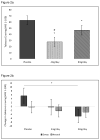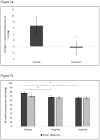Effect of doxazosin on stress reactivity and the ability to resist smoking
- PMID: 28440105
- PMCID: PMC5823502
- DOI: 10.1177/0269881117699603
Effect of doxazosin on stress reactivity and the ability to resist smoking
Abstract
Preclinical findings support a role for α1-adrenergic antagonists in reducing nicotine-motivated behaviors, but these findings have yet to be translated to humans. The current study evaluated whether doxazosin would attenuate stress-precipitated smoking in the human laboratory. Using a well-validated laboratory analogue of smoking-lapse behavior, this pilot study evaluated whether doxazosin (4 and 8 mg/day) versus placebo attenuated the effect of stress (vs neutral imagery) on tobacco craving, the ability to resist smoking and subsequent ad-libitum smoking in nicotine-deprived smokers ( n=35). Cortisol, adrenocorticotropin, norepinephrine, epinephrine, and physiologic reactivity were assessed. Doxazosin (4 and 8 mg/day vs placebo) decreased cigarettes per day during the 21-day titration period. Following titration, doxazosin (4 and 8 mg/day vs placebo) decreased tobacco craving. During the laboratory session, doxazosin (8 mg/day vs placebo) further decreased tobacco craving following stress versus neutral imagery. Doxazosin increased the latency to start smoking following stress, and reduced the number of cigarettes smoked. Dosage of 8 mg/day doxazosin increased or normalized cortisol levels following stress imagery and decreased cortisol levels following neutral imagery. These preliminary findings support a role for the noradrenergic system in stress-precipitated smoking behavior, and support further development of doxazosin as a novel pharmacotherapeutic treatment strategy for smoking cessation.
Keywords: Smoking; doxazosin; noradrenergic; smoking cessation; stress.
Conflict of interest statement
Sherry A. McKee has consulted to Cerecor and Embera, has received research support for investigator-initiated studies from Pfizer, Inc. and Cerecor, and has ownership in Lumme, Inc. All other authors declare that there is no conflict of interest.
Figures








Similar articles
-
Developing a laboratory model of smoking lapse targeting stress and brief nicotine deprivation.Exp Clin Psychopharmacol. 2018 Jun;26(3):244-250. doi: 10.1037/pha0000187. Exp Clin Psychopharmacol. 2018. PMID: 29863382 Free PMC article.
-
Pilot investigation of the effect of carvedilol on stress-precipitated smoking-lapse behavior.J Psychopharmacol. 2018 Sep;32(9):1003-1009. doi: 10.1177/0269881118767647. Epub 2018 Apr 25. J Psychopharmacol. 2018. PMID: 29692206 Free PMC article. Clinical Trial.
-
A preliminary investigation into the effects of doxazosin on cognitive functioning in tobacco-deprived and -satiated smokers.Hum Psychopharmacol. 2018 May;33(3):e2660. doi: 10.1002/hup.2660. Hum Psychopharmacol. 2018. PMID: 29878501 Free PMC article. Clinical Trial.
-
A translational investigation targeting stress-reactivity and prefrontal cognitive control with guanfacine for smoking cessation.J Psychopharmacol. 2015 Mar;29(3):300-11. doi: 10.1177/0269881114562091. Epub 2014 Dec 16. J Psychopharmacol. 2015. PMID: 25516371 Free PMC article. Clinical Trial.
-
Guanfacine alters the effect of stress and smoking on heart rate variability in regular daily smokers.Psychopharmacology (Berl). 2017 Mar;234(5):805-813. doi: 10.1007/s00213-016-4517-1. Epub 2016 Dec 27. Psychopharmacology (Berl). 2017. PMID: 28028603 Free PMC article.
Cited by
-
Closing the brain-heart loop: Towards more holistic models of addiction and addiction recovery.Addict Biol. 2022 Jan;27(1):e12958. doi: 10.1111/adb.12958. Epub 2020 Aug 12. Addict Biol. 2022. PMID: 32783345 Free PMC article. Review.
-
Developing a laboratory model of smoking lapse targeting stress and brief nicotine deprivation.Exp Clin Psychopharmacol. 2018 Jun;26(3):244-250. doi: 10.1037/pha0000187. Exp Clin Psychopharmacol. 2018. PMID: 29863382 Free PMC article.
-
Effects of Prazosin on Provoked Alcohol Craving and Autonomic and Neuroendocrine Response to Stress in Alcohol Use Disorder.Alcohol Clin Exp Res. 2020 Jul;44(7):1488-1496. doi: 10.1111/acer.14378. Epub 2020 Jun 12. Alcohol Clin Exp Res. 2020. PMID: 32449942 Free PMC article. Clinical Trial.
-
Modeling ability to resist alcohol in the human laboratory: A pilot study.Drug Alcohol Depend Rep. 2022 Oct 7;5:100105. doi: 10.1016/j.dadr.2022.100105. eCollection 2022 Dec. Drug Alcohol Depend Rep. 2022. PMID: 36844167 Free PMC article.
-
Acute prazosin administration does not reduce stressor reactivity in healthy adults.Psychopharmacology (Berl). 2019 Nov;236(11):3371-3382. doi: 10.1007/s00213-019-05297-x. Epub 2019 Jun 13. Psychopharmacology (Berl). 2019. PMID: 31197436 Free PMC article. Clinical Trial.
References
-
- Akduman B, Crawford ED. Terazosin, doxazosin, and prazosin: current clinical experience. Urology. 2001;58(6):49–54. - PubMed
-
- al’Absi M, Wittmers LE, Erickson J, et al. Attenuated adrenocortical and blood pressure responses to psychological stress in ad libitum and abstinent smokers. Pharmacology Biochemistry and Behavior. 2003;74(2):401–410. - PubMed
-
- al’Absi M, Hatsukami D, Davis GL. Attenuated adrenocorticotropic responses to psychological stress are associated with early smoking relapse. Psychopharmacology. 2005;181(1):107–117. - PubMed
-
- Carter BD, Abnet CC, Feskanich D, et al. Smoking and mortality—beyond established causes. New England journal of medicine. 2015;372(7):631–640. - PubMed
Publication types
MeSH terms
Substances
Grants and funding
LinkOut - more resources
Full Text Sources
Other Literature Sources
Medical

